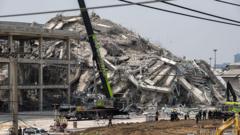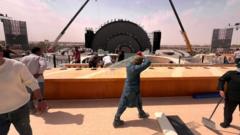A Thai court has issued 17 arrest warrants in connection with a skyscraper collapse in Bangkok that occurred during a recent earthquake, raising serious concerns over construction practices and regulations.
**Seventeen Arrest Warrants Issued Following Bangkok Skyscraper Collapse**

**Seventeen Arrest Warrants Issued Following Bangkok Skyscraper Collapse**
Authorities probe negligence as construction oversight comes under fire after deadly earthquake-triggered disaster.
The Bangkok skyscraper, intended to serve as the new State Audit Office, crumbled during a powerful 7.7 magnitude earthquake that originated in Myanmar in March. As a result, emergency responders recovered 89 bodies from the debris, while still searching for seven missing individuals. The police investigation has identified those responsible for the building's design, construction, and oversight, with the public spotlight on businessman Premchai Karnasuta, a former leader of one of Thailand's largest construction firms, Italian-Thai Development PLC.
Initial findings from the investigation hint at significant structural flaws, particularly within the lift shaft of the building. Local media reports indicate that these structural issues may have contributed to the catastrophic failure of the structure. The high-rise was characterized by its reflective blue glass and steel facade and had been under construction for three years, with costs exceeding two billion Thai baht (around $59 million).
Despite the quake's intensity, most of Bangkok’s buildings remained unscathed, but the State Audit Office suffered catastrophic damage. At the time of the incident, over 400 workers were present on-site, and a coordinated rescue operation ensued, utilizing drones, sniffer dogs, cranes, and excavators to locate survivors and recover victims.
As investigations continue, the tragedy raises questions about the standards and safety protocols within the construction industry in Thailand.
Initial findings from the investigation hint at significant structural flaws, particularly within the lift shaft of the building. Local media reports indicate that these structural issues may have contributed to the catastrophic failure of the structure. The high-rise was characterized by its reflective blue glass and steel facade and had been under construction for three years, with costs exceeding two billion Thai baht (around $59 million).
Despite the quake's intensity, most of Bangkok’s buildings remained unscathed, but the State Audit Office suffered catastrophic damage. At the time of the incident, over 400 workers were present on-site, and a coordinated rescue operation ensued, utilizing drones, sniffer dogs, cranes, and excavators to locate survivors and recover victims.
As investigations continue, the tragedy raises questions about the standards and safety protocols within the construction industry in Thailand.



















